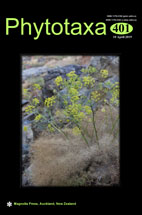Abstract
The lichenized genus Graphis sensu Staiger (Graphidaceae) is listed with 67 species in the most recent version of the Catálogo de Plantas y Líquenes de Colombia. Revision of recent publications and approximately 700 collections housed in the Cryptogams Section of the Herbario Forestal “Gilberto Emilio Mahecha Vega” of the Universidad Distrital Francisco José de Caldas in Bogotá revealed 70 additions to the Colombian lichen biota in this genus and the recently segregated genus Allographa, including 13 species new to science, from the departments of Boyacá, Casanare, Cauca, Cesar, Cundinamarca, Meta, Nariño, Santander, and Tolima. In this paper, six new species of Graphis with transversely septate ascospores are described, illustrated, and discussed. The new taxa are: Graphis amaliana, with lirellae becoming striate, laterally carbonized excipulum, clear hymenium, large, transversely septate ascospores, and norstictic acid; differing from Allographa celata and A. verminosa in the verrucose thallus and erumpent lirellae with verruculose thallin margin, as well as in the broader ascospores; G. carmenelisana with labia becoming striate, completely carbonized excipulum, inspersed hymenium (type A), large, transversely septate ascospores, and stictic acid; differing from Graphis gloriosensis in the rugose-verruculose thallus and the radiately branched lirellae with apically thin complete thalline margin and labia becoming striate; G. kavintuca with entire lirellae, laterally carbonized excipulum, clear hymenium, small to medium-sized, transversely septate ascospores, and lacking substances; differing from A. elongata in the lirellae lacking a thalline margin and from A. nana in the larger ascospores and the longer, flexuose lirellae; G. rosalbinana with lirellae becoming striate, completely carbonized excipulum, clear hymenium, small, transversely septate ascospores, and norstictic acid; differing from G. schiffneri in the shape and disposition of the lirellae; G. santanderiana with entire lirellae, laterally carbonized excipulum, clear hymenium, small, transversely septate ascospores, and lacking secondary substances; differing from G. imshaugii in the laterally carbonized excipulum and lack of secondary substances; G. solmariana with entire lirellae, laterally carbonized excipulum, clear hymenium, large, transversely septate ascospores, and stictic acid; differing from G. sitapurensis in the basal thalline margin and the broader ascospores. A remarkably high number of new species are from high altitude andine forest and paramo, habitats previously not believed to be rich in Graphis species.

